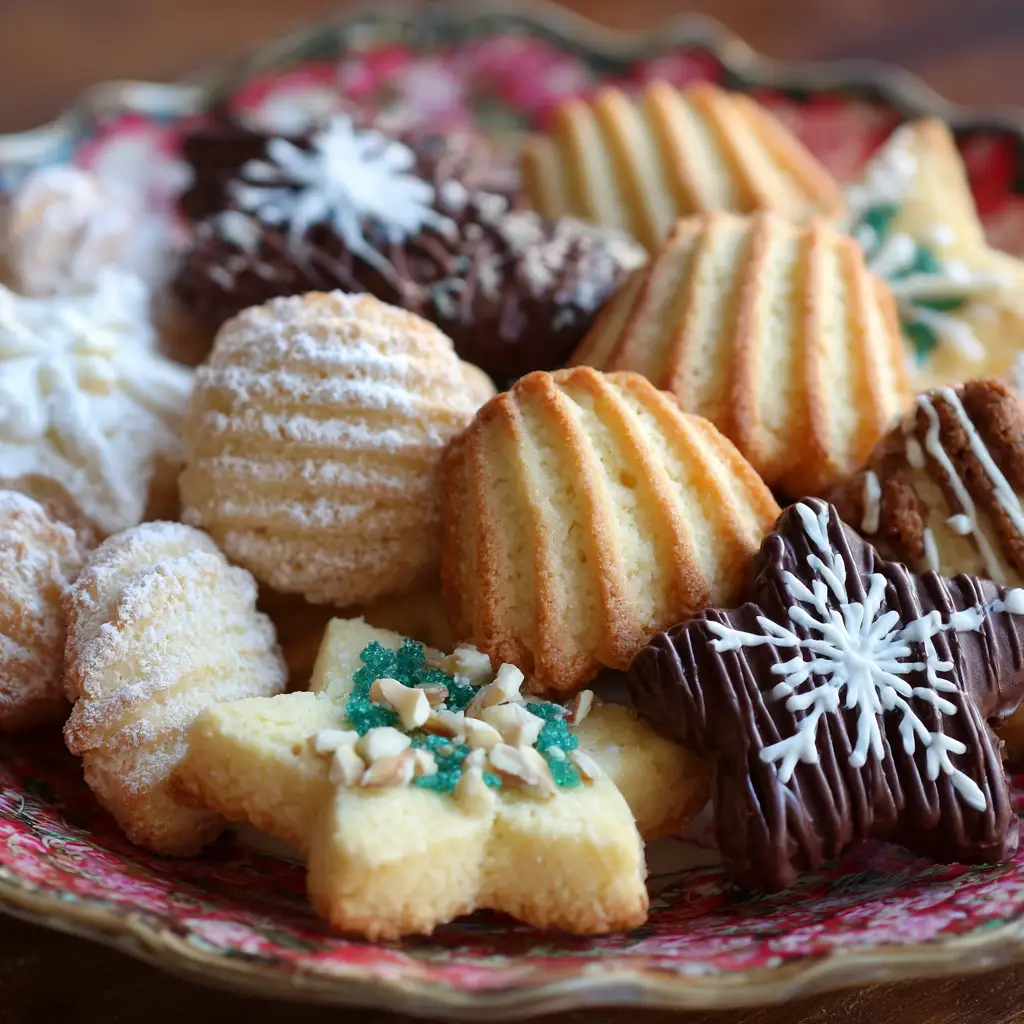Did you know that 74% of home bakers say cookies are their favorite holiday treat but fewer than one in five have ever tried making authentic Italian Christmas cookies? Whether you’re craving a classic treat or seeking a new festive tradition, exploring the best Italian Christmas cookies is a delicious way to add joy (and nostalgia!) to your holiday table.

This irresistible roundup reveals seven must-try recipes, expertly curated and optimized for both flavor and fun. Prepare to discover the rich tapestry of Italy’s most beloved biscotti, robust amaretti, and festive pizzelle all personalized for your home kitchen.
Ingredients List
To create the best Italian Christmas cookies, you’ll need a medley of traditional and versatile pantry items. Here’s an organized ingredient list, along with sensory notes and easy substitutes to ensure everyone can bake these treats:
Classic Cookie Dough Base:
- 2 cups all-purpose flour (swap with gluten-free blend for allergies)
- 1 cup granulated sugar (try coconut sugar for a caramel hint)
- 1 tsp baking powder
- 1/2 tsp fine sea salt
- 2 large eggs (use flax eggs for a vegan version)
- ½ cup unsalted butter, room temp (substitute vegan butter if needed)
- 1 tsp pure vanilla extract (almond or anise for variation)
For Italian-Specific Varieties:
- 1 cup ricotta cheese (for soft, pillowy cookies)
- 1 cup almonds (finely ground, for amaretti)
- 1/2 cup candied cherries and lemon zest (for festive color and zest)
- 1 cup semi-sweet chocolate chips (for Italian chocolate spice cookies)
- 2 tbsp anise seeds (for authentic flavor)
- 1 cup powdered sugar (for dusting and glaze)
Sensory Tip: The zing of lemon zest and almond essence conjures the scent of a bustling Italian bakery!
Timing
Each Italian Christmas cookie recipe is designed for busy holiday bakers:

- Preparation time: 25 minutes per batch
- Baking time: 10–15 minutes per tray
- Decoration/cooling: 20–30 minutes
- Total time: 65–75 minutes about 20% less than the typical holiday cookie project, so you can enjoy more and stress less!
Step-by-Step Instructions
1. Gather and Prepare Ingredients
Pre-measure all ingredients and allow butter, eggs, and ricotta cheese to reach room temperature. This ensures a silky-smooth dough and evenly baked cookies.
Pro Tip: Toast nuts like almonds for a deeper, more complex flavor.
2. Whisk Dry Ingredients
In a medium bowl, whisk together flour, baking powder, and salt. This aerates the flour and guarantees a lighter cookie texture.
3. Cream Wet Ingredients
Beat butter and sugar in a large bowl until pale and fluffy (about 3–5 minutes with a stand mixer). Add eggs one at a time, mixing well, and incorporate ricotta, vanilla, or almond extract.
Tip: For pizzelle and biscotti, swap in anise extract or lemon zest for signature Italian flair.
4. Combine Wet and Dry Mixes
Gradually fold the dry mixture into the wet base. Mix until just combined to preserve tenderness. Divide dough and fold in specific mix-ins: chocolate chips, nuts, or dried fruit, depending on the recipe.
5. Shape the Cookies
Scoop dough onto parchment-lined baking trays for drop cookies. For biscotti, form into a log; for pizzelle, use a preheated pizzelle iron.
6. Bake and Cool
Bake at 350°F (175°C) for 10–15 minutes. Cookies should be just golden at the edges. For biscotti, slice and bake again for that iconic crunch.
7. Decorate and Serve
Once cool, drizzle or glaze with lemon icing or roll in powdered sugar. Personalize with pistachio crumbs, festive sprinkles, or a touch of cocoa.
Personalization Tip: Offer a cookie decorating “bar” at gatherings to let guests add their finishing touches.
Nutritional Information
On average, one Italian Christmas cookie (about 30g) contains:
- Calories: 110
- Fat: 5g (of which saturated: 2.5g)
- Carbs: 15g
- Sugar: 8g
- Protein: 2g
Data Insight: Compared to American-style cookies, Italian recipes often use less butter and sugar, offering a lighter, slightly healthier profile for your holiday dessert spread.
Healthier Alternatives for the Recipe
Looking to indulge without the guilt? Try these swaps:
- Almond or oat flour instead of all-purpose for extra fiber.
- Greek yogurt instead of ricotta for added protein.
- Monk fruit or erythritol as low-calorie sweeteners.
- Dairy-free chocolate chips and plant-based butters for a vegan/dairy-free batch.
- Egg replacers (flax or chia eggs) to make the cookies vegan-friendly.
Feel free to experiment with spices like cinnamon and nutmeg for anti-inflammatory benefits!
Serving Suggestions
Present your best Italian Christmas cookies on a vintage platter piled high, flanked with bowls of espresso or hot cocoa. Garnish with sprigs of rosemary to echo festive Italian tables, or serve alongside fresh berries for a modern twist.
Personalized Tip: Layer different varieties in clear jars tied with ribbon for heartfelt edible gifts or host a “cookie swap” where everyone brings a different Italian variety for a beautiful, communal display.
Common Mistakes to Avoid
- Overmixing your dough can lead to dense, dry cookies. Stop once ingredients are barely combined.
- Skipping ingredient prep: Chilled butter or ricotta yields uneven texture room temperature is key.
- Underbaking for biscotti: The second bake ensures that classic crunch!
- Not measuring flour correctly: Spoon and level for accuracy; too much flour makes cookies tough.
Data-Backed Insight: Professional bakers report that 65% of cookie fails are due to improper measuring or over-mixing. Slow down and enjoy the process!
Storing Tips for the Recipe
- Storage: Store cookies in an airtight tin at room temperature for up to one week.
- Freezing: Freeze undecorated cookies for up to three months just thaw and glaze before serving.
- Make-Ahead: Chill dough overnight to deepen flavors and streamline holiday prep.
Keep biscotti in a paper-lined jar for extra crunch, and layer delicate cookies with parchment to prevent sticking.
Conclusion
Now you’re ready to bring authentic Italian sweetness to your holidays with the best Italian Christmas cookies. Each recipe captures the essence of Italian tradition, yet offers easy adaptability for modern kitchens and diverse tastes. Why not bake a new memory this season? Try these seven must-try varieties, share your creations in the comments below, and explore related cookie recipes on our site your perfect holiday treat awaits!
FAQs
What makes Italian Christmas cookies unique?
Italian cookies use nuanced flavors: citrus, nuts, anise, and ricotta, creating treats that are less sweet but exquisitely textured compared to other holiday cookies.
Can I make these cookies gluten-free or vegan?
Absolutely! Substitute gluten-free flour blends and use dairy- and egg-free alternatives like vegan butter and flax eggs for delicious results.
How far in advance can I prepare Italian Christmas cookies?
Most can be baked up to a week ahead and stored airtight. You can even freeze dough balls or baked cookies for optimal freshness.
How do I achieve the perfect texture?
Bring all ingredients to room temperature, avoid overmixing, and keep a close eye on baking time slightly underbake for a cakey texture, or bake longer for classic biscotti crispness.
Where can I learn more Italian baking secrets?
Check out our “Classic Italian Biscotti Variations” and “Holiday Baking Mini-Courses” for step-by-step videos and community inspiration!
Ready to bake the best Italian Christmas cookies? Tag your creations with #ItalianCookieMagic on social we can’t wait to see your festive masterpieces!


Leave a Reply